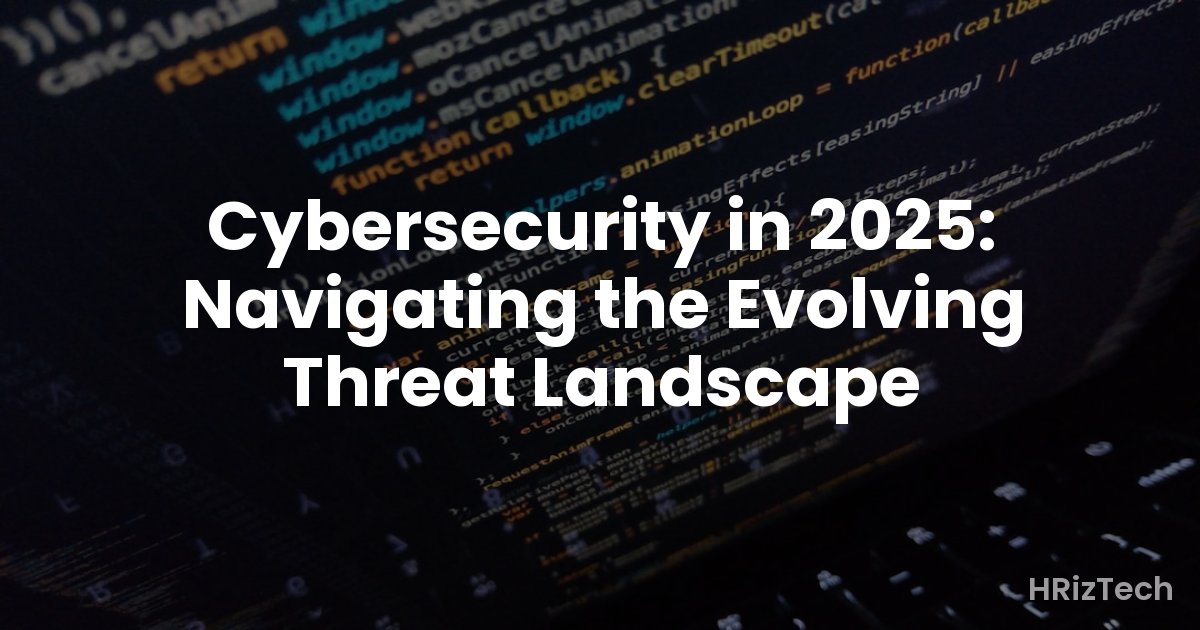Cybersecurity in 2025: Navigating the Evolving Threat Landscape

Cybersecurity in 2025: Navigating the Evolving Threat Landscape
- AI is revolutionizing both offensive and defensive cybersecurity strategies.
- The rise of IoT devices expands the attack surface significantly.
- Human error remains a major vulnerability, demanding robust security awareness training.
- Proactive threat hunting and incident response planning are crucial.
- Collaboration and information sharing are key to combating sophisticated cyber threats.
The Shifting Sands of the Cyber Threat Landscape
The digital world is a constantly evolving battlefield, and cybersecurity in 2025 will be a far cry from what we know today. The sophistication and scale of cyberattacks are escalating rapidly, driven by increasingly advanced technologies and the ever-expanding digital footprint of individuals and organizations. Gone are the days of simple phishing scams; today's threats are highly targeted, often leveraging artificial intelligence (AI) and machine learning (ML) for maximum impact.
The Rise of AI in Cybersecurity: A Double-Edged Sword
AI is a game-changer, impacting both the offensive and defensive sides of cybersecurity. On the offensive side, AI-powered tools are automating malicious activities, making attacks more efficient and harder to detect. Think sophisticated phishing campaigns that personalize messages with uncanny accuracy, or malware that adapts its behavior to evade security systems.
However, AI also presents a powerful weapon for defenders. AI-driven security solutions can analyze vast amounts of data to identify anomalies and predict potential threats in real-time. This allows for proactive threat hunting and faster incident response, mitigating the damage before it escalates.
AI-Powered Threat Detection and Response
Advanced AI algorithms can analyze network traffic, user behavior, and system logs to detect subtle indicators of compromise (IOCs) that might be missed by traditional security tools. This proactive approach allows organizations to identify and neutralize threats before they cause significant damage. Furthermore, AI can automate incident response processes, speeding up containment and recovery efforts.
The Expanding Attack Surface: The Internet of Things (IoT)
The proliferation of IoT devices – from smart home appliances to industrial control systems – significantly expands the attack surface for cybercriminals. These devices often lack robust security features, making them easy targets for exploitation. A compromised IoT device can serve as a gateway to a larger network, providing attackers with a foothold to launch more damaging attacks.
Securing the IoT Ecosystem
Securing the IoT requires a multi-faceted approach. This includes implementing strong authentication mechanisms, regularly updating firmware, and segmenting networks to limit the impact of a compromise. Organizations must also prioritize vendor security and select devices with robust security features. A comprehensive security strategy must encompass the entire IoT ecosystem, not just individual devices.
The Human Factor: Still the Weakest Link
Despite technological advancements, human error remains a major vulnerability. Phishing attacks, social engineering scams, and accidental data breaches continue to be significant threats. Employees are often the first line of defense, and their awareness and training are critical in preventing many attacks.
Investing in Security Awareness Training
Effective security awareness training goes beyond simple awareness campaigns. It needs to be interactive, engaging, and tailored to the specific threats faced by the organization. Regular training sessions, simulations, and phishing tests are crucial in keeping employees vigilant and aware of the latest threats.
Proactive Security: Threat Hunting and Incident Response
In the face of increasingly sophisticated attacks, a reactive approach to cybersecurity is no longer sufficient. Organizations need to adopt a proactive stance, actively hunting for threats and planning for potential incidents. This involves continuous monitoring of systems and networks, regular vulnerability assessments, and the development of robust incident response plans.
Building a Resilient Security Posture
A resilient security posture relies on a combination of preventative measures, detective controls, and responsive actions. This includes regular security audits, penetration testing, and the implementation of security information and event management (SIEM) systems to monitor security events and identify potential threats.
Collaboration and Information Sharing: A Collective Defense
Cybersecurity is a collective challenge, and collaboration is crucial in combating sophisticated threats. Organizations need to share information about emerging threats, vulnerabilities, and attack techniques. This can be achieved through industry groups, government agencies, and information sharing platforms.
Building a Community of Practice
Sharing threat intelligence and best practices helps the entire cybersecurity community to strengthen its defenses. By working together, organizations can better anticipate, prevent, and respond to cyberattacks, creating a more secure digital environment for all.
Looking Ahead: The Future of Cybersecurity
Cybersecurity in 2025 will be defined by a combination of advanced technologies, evolving threats, and a renewed focus on human factors. The increasing reliance on AI, the expanding IoT ecosystem, and the persistent threat of human error will continue to shape the landscape. Organizations must adapt to these changes by investing in robust security solutions, training their employees, and fostering collaboration across the industry.
The future of cybersecurity depends on our ability to anticipate, adapt, and collaborate. Only through a collective effort can we effectively navigate the evolving threat landscape and build a safer digital world.
Comments
No comments yet. Be the first to comment!